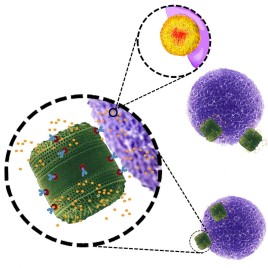For the first time researchers have shown that stimulating cardiac muscle cells, derived from stem cells, with electrical impulses improves their development and function. Providing these cells with the improved function could potentially help treat cardiovascular disease, one of the world’s major illnesses, as it may provide a way to regenerate heart muscle. When stimulated […]
Tag: medicine
High-rise equals high-risk for cardiac arrest patients
Living on a higher floor means a person has a smaller chance of surviving cardiac arrest, according to the authors of a new study. Researchers believe this effect is caused by the extra time it takes emergency personnel to reach the patient. The study examined data from over 8,000 adults who suffered out-of-hospital cardiac arrest […]
Mammals, including humans, shape their microbiome
Humans create small molecules inside the GI tract to help regulate the composition of gut microbes and to protect against intestinal diseases. The researchers believe the findings of the study reveal a host defense mechanism and show that microRNAs can be used to regulate the microbiome of individuals. The researchers found microRNAs produced by intestinal cells in both mice and humans regulate the activity […]
Biologics and Biosimilars | SMCC Webinar
Biologics and Biosimilars | SMCC Webinar | January 7, 2016 | Video available Biopharmaceuticals, or Biologics have successfully improved the care of several hard to treat conditions, such as rheumatoid arthritis, Crohn’s disease and cancer. More of these complex biological drugs are coming. In the US over 900 biologics are being developed for more than 100 diseases. While they […]
Dear, Health Minister – some friendly advice
The editors of the Canadian Medical Association Journal published a letter to Canada’s new Minister of Health, Dr. Jane Philpott. They called on Dr. Phillpott to let science and evidence guide policy. The authors also asked the new minister to follow through on her promises to expand home care, improve vaccination rates, and address mental […]
DNA stutters provide a hidden layer of information
Repetitive pieces of DNA, previously thought to be “junk”, play an important role in regulating how genes are expressed, according to a recent study. Short Tandem Repeats (STRs), are sections of DNA which are repeated, similar to a stutter. Researchers found STRs are able to fine tune the expression of nearby genes, and that different […]
Saving with supervised injection sites
Creating supervised injection facilities in Toronto and Ottawa would be a cost-effective way to prevent people from developing hepatitis C, according to an updated analysis. The researchers believe there is an 86 per cent chance one or more supervised injection facilities would be cost-effective in Toronto, and a 90 per cent chance in Ottawa. They […]
Using Statistics Canada information to reveal opioid trends
Researchers believe they have found a way to use Statistics Canada data to accurately estimate rates of opioid-related deaths nation-wide. The algorithm they developed may be useful for provincial and federal public health agencies, helping to quickly identify and report on trends in opioid overdoses across Canada. Original research paper published in the CMAJ on November 30, 2015. […]

Fighting cancer with algae
A microscopic algae, called diatoms, have been genetically altered to target and deliver drugs to cancerous cells without harming healthy tissue. Researchers used a two-step strategy to attach antibodies as well as drug molecules to the algae, creating a targeted delivery system. The authors of the paper say the efficacy of the system, as well […]
Repairing DNA in a matter of weeks
Reprogramming and genetically correcting stem cells can be achieved in as little as two weeks thanks to a new technique. This advance could offer potential therapies for individuals with a range of genetic disorders. Previous techniques to create stem cells from a patient’s tissue and reprogram the stem cell to remove a negative mutation took […]

Human sperm are surface swimmers
Human sperm are able to swim faster and straighter when they are close to a surface by adopting a unique ‘slither’ according to new research. The research team believes this slither may have adapted to the confined space in the reproductive system. Researchers filmed human sperm swimming within a micron of a glass surface and […]
As tough as tendons on bone: The new hydrogel
Researchers have developed a hydrogel which is more than 90 per cent water and able to adhere to slippery surfaces with the strength of tendon adhering to bone. They believe the gel will be ideal for protective coatings on underwater surfaces, such as boats, oil rigs, and submarines. The hydrogel is able to stick to glass, silicon, […]
Research is too conservative
A pair of papers calls for researchers to take greater risks when choosing research problems to study in order to speed up scientific discovery and innovation. The two papers, one from PNAS and another from the American Sociological Review, used computer models to analyze millions of research papers. The study published by PNAS found that […]
Brain cancer cells form connected network
Microtubes connecting brain tumor cells allow a specific type of brain cancer, known as gliomas, to spread quickly and become resistant to radiation therapy, a new study shows. This knowledge will allow researchers to target for future treatment efforts. These microtubes allow cancerous cells to reach out and form connections, allowing them to grow as […]
APGAR scores provide clues about the mothers’ health
Researchers found a strong correlation between a newborn’s Apgar score and whether the mother will be admitted to the ICU after delivery. The researchers hope these findings will help doctors predict which mothers will become critically ill after giving birth, and may help predict which mothers need additional medical checks. The study analyzed data from […]
Stomach fat increases risk of diabetes during pregnancy
Women with a high level of abdominal fat during the first trimester of pregnancy have a higher risk of developing gestational diabetes later on during pregnancy, according to a new study. Researchers measured the abdominal fat of 485 women during the end of their first trimester (11 – 14 weeks), and later measured their oral […]